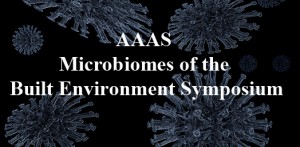The following is the Executive Summary of a report on the AAAS “Microbiomes of the Built Environment Symposium”, March 27th, 2014, funded by the Alfred P. Sloan Foundation. The full report can be found here.
The research field of Microbiomes of the Built Environment (MoBE) is relatively new, evolving about ten years ago from the discovery that humans are exposed to tremendous numbers and diverse species of bacteria, viruses, fungi, and protozoa inside the environments that we build. All built environments, including homes, offices, airplanes, and more, contain these microbial communities, or “microbiomes.” These microbiomes affect our structures through mold and corrosion, as well as influence our health both positively and negatively. As a result, understanding what microorganisms are present and how they behave in this ecosystem is critically important not only for human health, but for how we design and interact with the built environment.
Through its Microbiology of the Built Environment Program, the Alfred P. Sloan Foundation (the Sloan Foundation) has taken a leadership role by catalyzing a community of researchers, supporting over 50 distinct research projects since 2005. The Sloan Foundation recently awarded the American Association for the Advancement of Science’s (AAAS) Research Competitiveness Program (RCP) a grant to hold a one-day symposium in order to present MoBE research to federal agencies and other stakeholders. RCP organized this symposium, conducted on March 27th, 2014, at the AAAS headquarters in Washington, D.C., in close proximity to federal agencies and nonprofit associations.
The symposium had two goals: 1) to showcase the diversity and impact of the research supported by the Sloan Foundation’s MoBE Program, as well as other research in the field; and 2) to create a dialogue among the researchers and the broader stakeholder community.
In consultation with the Sloan Foundation, RCP selected 20 speakers and moderators representing a breadth of topics and approaches critical to federal agencies, nonprofit associations, and industry. Topic coverage via four panels focused on: 1) The science and diversity of MoBE research; 2) differences among microbiomes and their impact on infrastructure; 3) their impact on human health; and 4) the use of this knowledge to manage building design, energy efficiency, biosecurity, and more. A final panel then presented an overview and discussed next steps and research needs. Also to promote discussion with attendees, the agenda included Q&A sessions, long networking breaks, and an evening reception.
To determine who to invite, RCP conducted a stakeholder analysis based on the potential impacts of the field. We then contacted the various organizations directly to gauge interest, which was strong with almost 50% of those contacted replying and/or registering. This stakeholder audience remained the main focus until one month before the symposium, after which remaining space was opened to wider groups like the Federal Green Building listserve, and then to the broad AAAS community. As a number of federal attendees could not travel to the symposium, RCP further decided to both livestream and video-record the event, and created a hashtag #aaasmobe to support tweeting. RCP also coordinated with the AAAS Office of Government Relations to present a Capitol Hill briefing by three of the symposium’s speakers, who emphasized topics on infrastructure and human health. This briefing was video-recorded as well and each talk is available online. Finally, three weeks after the symposium, RCP conducted separate surveys of the speakers and attendees to determine the symposium’s impact and potential next steps of the field.
More than 85 individuals representing 50 agencies and organizations attended the symposium. In addition, over 50 participants accessed the symposium via a live webcast, and 30 registered for the Hill briefing. The online videos of the symposium have now reached almost 300 views and continue to be accessed daily (numbers for the videos of the Hill briefing are not available). As tweeting of the symposium was very active, one of the speakers, Dr. Jonathan Eisen, also created an archive of the tweets that has since been widely viewed.Besides the introduction of this new field to the audience and the clear presentation of its impacts, the symposium has led to several actions, including: 1) 90% of the attendees have recommended that colleagues learn more about the MoBE, according to the survey; 2) two news stories were published; and 3) approximately 60% of symposium participants are pursuing contacts made during the event. Also, one of the major outcomes of this symposium and the main reason for this report is the compilation of needed actions discussed among the speakers and attendees during the event. These needs included: research tools and methods; communication; microbiome, building, and health-focused research; research at the intersection of MoBE and health, and research towards applications.
As noted by the speakers and many of the attendees of the symposium, the MoBE field is critically important in our globally connected world. AAAS and the RCP are very pleased to have been involved in the event’s organization, especially in helping create a continuing dialogue among the leading MoBE researchers and stakeholders. AAAS looks forward to engaging with this community as it continues to grow and evolve.
